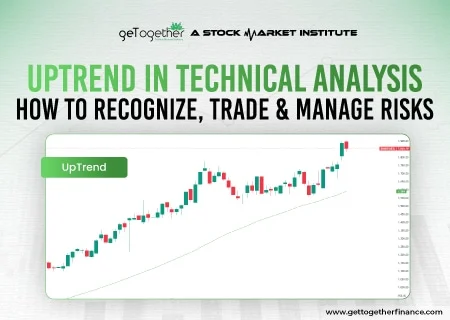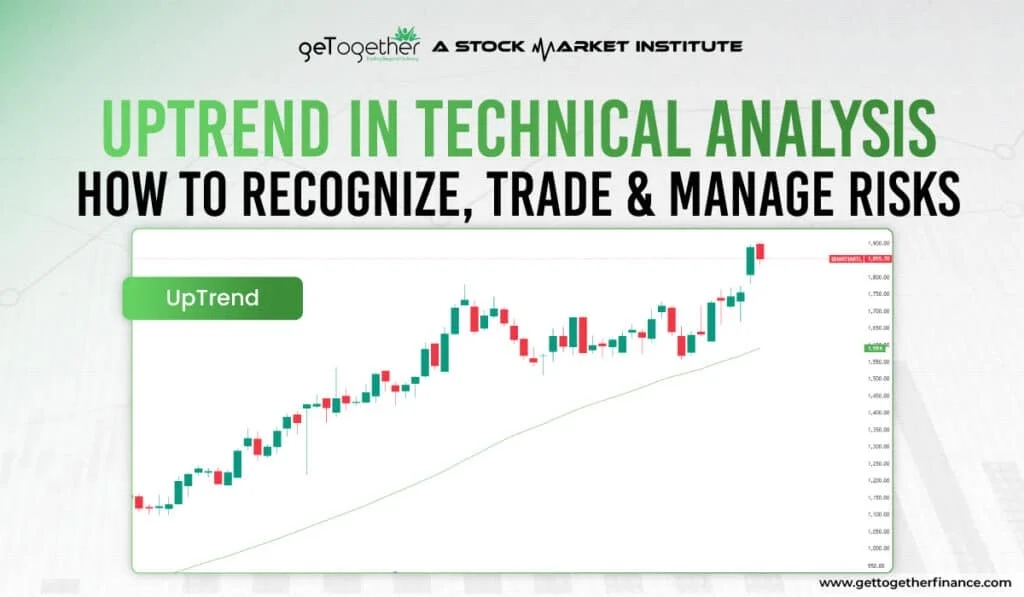Uptrend in Technical Analysis: How to Recognize, Trade & Manage Risks
- May 4, 2025
- 2430 Views
- by Manaswi Agarwal


In technical analysis, prices are very much reliable on strong indicators in which uptrend ensures ongoing price movement in upwards direction. It describes the overall movement of the security in the market but how to trade an uptrend in technical analysis? OR Where to buy or sell the securities during an uptrend? These are the common questions among the traders, for which the answer is provided with this blog.
Table of Contents
ToggleWhat is an Uptrend?

Uptrend is a crucial technical indicator which signifies the movement of overall market or securities over the past few days. Uptrend is like the climbing stairs where each high is the peak and the prices keep going higher. When the prices in a security continuously rise upwards with short pullbacks over the long term, it indicates a sustained buying pressure with an uptrend move.
Now here comes the question: how to recognize an uptrend?
Recognition of an Uptrend

To identify any technical analysis pattern in the security, an analyst must understand the formation of candles with their highs and lows. Recognizing an uptrend is identifying the sequence of higher highs or higher lows or calculating the moving averages.
Higher Highs and Higher Lows
To recognize an uptrend, look for the formation of higher highs and higher lows on the chart. When higher highs are formed continuously, a strong buying pressure in the security is confirmed. Higher highs suggest the peak level of prices with a sustained buying pressure, on the other hand, higher lows signifies aggressive entry of buyers at the time of retracement.
Moving Averages
Moving averages determine the average of prices over the past period. A moving average will calculate the total average of opening and closing prices of the last 50 days. If the current prices range above the level of moving average, it is determined as an uptrend.
A moving average can be calculated at every time frame as well as consider different time periods like 50 days, 100 days, 200 days etc. Many traders tend to use SMA 50 to get the moving averages for a shorter time period, on the other hand, some use 100 or 200 EMA to gain broader insights.
Real Insight: EMA 20 is one powerful indicator that tends to push the prices upwards.
How to trade an Uptrend?

A common strategy adopted by traders to trade an uptrend is PULLBACK. It is an action when price rises and then retraces back which gives a chance to step into the uptrend and enjoy certain profits. When the prices move in a single trend, it always retraces in an attempt to make a new swing high. This attempt of making a new swing high is perceived as a buying opportunity by traders to ensure profits.
However, trading uptrend is quite risky as it never lasts forever. The trend changes very quickly when the prices take a U-turn, therefore relying on uptrend movement only is not preferable. Though uptrend can be a great technical indicator when a trader makes its efficient use with demand and supply approach.
If demand zones of higher time frames are supported by uptrend on lower time frames, traders can go long for the position with appropriate top down approach, sector support, volume, etc.
Benefits of Uptrend Trading
Trading in an upward trend lets the traders enjoy the move of increasing trend and make most of the profits with limited risks.
Risks of Trading in Uptrend

Trading in an ongoing upward direction can be very profitable but traders are required to be quite cautious because of market volatility and changing market trends.
Subjectivity
A trader cannot completely rely on trading uptrend in the security as it is subjective in nature. Each trader deals with a different perspective while trading on chart pattern or trend analysis.
Dependence on Historic Data
Trading based on trend analysis is highly dependent on historical data as the chart repeats history. However, new patterns and trends can arise anytime which is quite unpredictable and hence traders cannot always rely on previous data to trade on current trend formation.
Interesting Psychology of an Uptrend
Many traders make use of uptrend trading as a result of Fear of Missing Out. Escalating prices in an uptrend builds fear among traders to miss the profitable opportunities. It is quite necessary to avoid impulsive trading decisions that can erode your capital. A predefined trading plan with strategies that aligns well with your risk tolerance should be adopted.
Risk Management
Trading solely based on trend analysis and relying on trend movement does not give proper entry or exit as buyers might find opportunities quite later than the actual move. The actual move already takes place at the demand zones with appropriate risk management measures. Therefore, a strong technical approach is required to ensure proper management of risks and avoid losses.
FAQs
What is an Uptrend?
A continuous rising upward movement in the asset prices determines an uptrend. An uptrend lasts for a longer period.
How to trade an uptrend?
To trade an uptrend, you have to analyze the complete price action of a security. With an uptrend in the security, you can trade the pullbacks when price retraces or can rely on the demand and supply approach for a successful trade.
Can an uptrend last forever?
In more than 95% cases, it has been observed that the trend never lasts forever; it has to reverse at some point.
How to recognize an uptrend in the security?
A common property to recognize an uptrend in the security is the formation of higher highs and higher lows. The price continuously forms new peaks after giving a pullback to form a defined continued uptrend.
What if an uptrend starts Reversing?
If an ongoing uptrend starts to reverse, it can be a signal of a pullback if it is followed for the short term while it can signal a complete reversal of uptrend in the security with a continuation of downtrend.



 Instagram
Instagram
